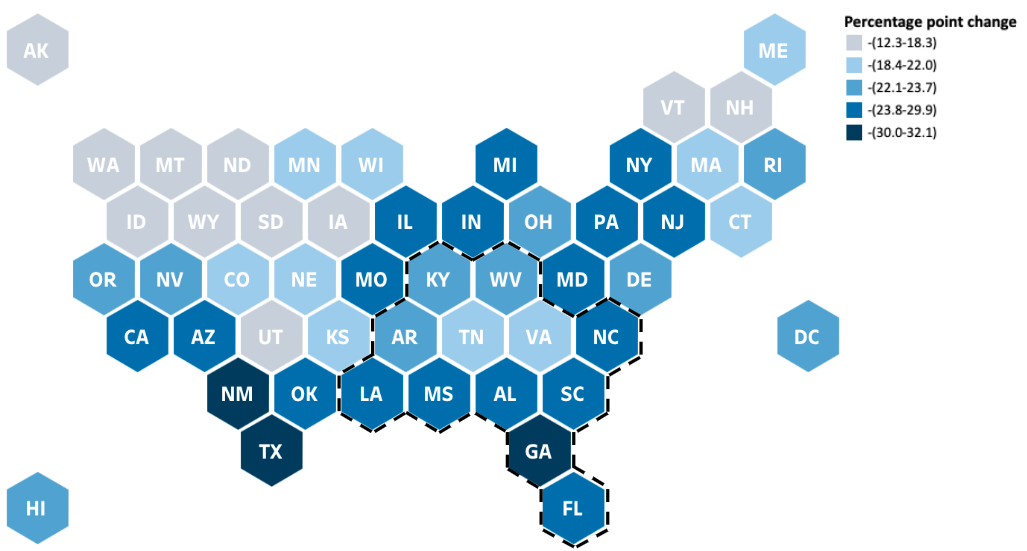ACS response rates
Response rates for the American Community Survey declined 25 percentage points (from 96% to 71%) between 2015 and 2020. Response rates declined the most in Georgia, New Mexico, and Texas.
Declines in American Community Survey response rates by state
Percentage point change, 2015 to 2020 (housing units)
Source: U.S. Census Bureau.
Survey research and, most glaringly, political polls have become less reliable and predictive in recent years due to declining response rates and because those who respond may have different attributes than those who do not.1,2,3 One survey of such size and mandate that it should not suffer from these issues is the American Community Survey (ACS). As the nation’s largest household survey, with more than 2 million households responding per year, the ACS is the source of the most accurate, up-to-date, and detailed information about U.S. communities of any size. Its response rate has typically been well over 90 percent. But the unique challenge of the Covid pandemic pushed ACS response rates lower, particularly among lower-income households.4,5,6 The response rate was so low in 2020 that the Census Bureau concluded the results did not meet statistical quality standards, and published the data only at the state level, marking it “experimental.” Because disasters accelerate pre-existing trends, overall survey response rates may continue to drop. Thus, the likelihood of lower-income households and other consistently-missed populations responding may remain diminished, requiring weighting and sample enlargement, as well as overdue investment in data infrastructure.
“Polling Problems and Why We Should Still Trust (Some) Polls”. Clinton. Vanderbilt. January, 2021. https://www.vanderbilt.edu/unity/2021/01/11/polling-problems-and-why-we-should-still-trust-some-polls/
“Internet Surveys”. Pew Research Center. https://www.pewresearch.org/politics/methodology/collecting-survey-data/internet-surveys/
“Nonresponse Bias: Explanation & Examples”. Zach. Statology.org. May, 2019. https://www.statology.org/nonresponse-bias/
“An Overview of Addressing Nonresponse Bias in the American Community Survey During the COVID-19 Pandemic Using Administrative Data”. Rothbaum, Eggleston, Bee, Klee, and Mendez-Smith. U.S. Census Bureau. November, 2021. https://www.census.gov/newsroom/blogs/random-samplings/2021/11/nonresponse-acs-covid-administrative-data.html
“Addressing Nonresponse Bias in the American Community Survey During the COVID-19 Pandemic Using Administrative Data”. Rothbaum, Eggleston, Bee, Klee, and Mendez-Smith. U.S. Census Bureau. November, 2021. https://www.census.gov/library/working-papers/2021/acs/2021_Rothbaum_01.html
“An Assessment of the COVID-19 Pandemic’s Impact on the 2020 ACS 1-Year Data”. Daily, Cantwell, Battle, Waddington, and Shin. U.S. Census Bureau. October, 2021. https://www.census.gov/content/dam/Census/library/working-papers/2021/acs/2021_CensusBureau_01.pdf

